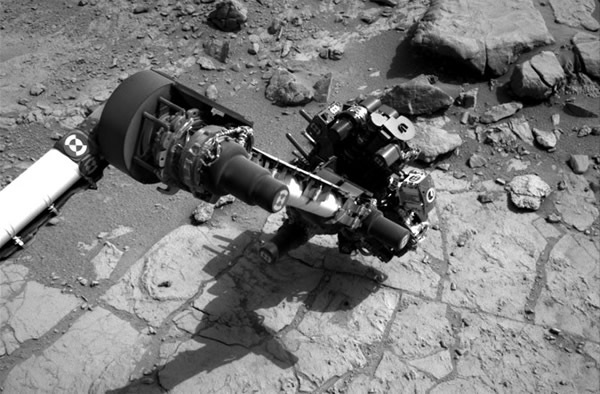Curiosity Asks: Where Are the Mars Organics?
Curiosity inspects the drill hole with its robotic arm-mounted Mars Hand Lens Imager (MAHLI) camera.
Organic carbon, even if it didn’t come from life, should be all over Mars, which, like Earth, is believed to have been pummeled by organic-rich comets and asteroids early in its history.
The destructive effects of ultraviolet and cosmic radiation, combined with what appears to be a ubiquitous layer of organic-consuming chemicals produced by so-called perchlorates on the surface of Mars, have driven the quest for organics underground. Inside rocks may be evidence of a different, organic-friendlier time in the planet’s history.
On Tuesday, scientists with NASA’s Mars Curiosity rover mission are due to report the first chemical analysis of powder drilled out from inside a rock at the Gale Crater landing site.
Scientists already know that the inside of the target rock is not as oxidized as its exterior.
The powder was delivered into a sampling scoop and photographed before being processed by two onboard laboratory instruments. The powder appeared gray, while the rock’s surface, like most of Mars, is red due to oxidized iron, or rust, that is globally distributed by the planet’s winds.
“The oxidation layer at least here is pretty thin, so that is encouraging,” NASA’s Mars exploration lead scientist Michael Meyer said at a Feb. 27 Mars program planning group meeting.
Curiosity touched down on Aug. 6 inside a 93-mile wide impact crater located near the planet’s equator. Scientists were drawn to a three-mile high mound of what appears to be layered sediments as a place to assess if the planet most like Earth has or ever had the ingredients to support and preserve life.
The building blocks for life, at least life as we know it, includes water, an energy source and organics.
Curiosity’s first science target was not Mount Sharp, which rises from the center of Gale Crater, but a region in the opposite direction originally named Gleneg and later referred to as Yellowknife Bay.
Images and analysis from Mars orbiters show the area has three different types of terrain and that it has a low elevation.
“If water flows downhill on Mars, then this may be where it could have ponded,” Meyers said.
Mar 11, 2013 02:30 PM ET by Irene Klotz












